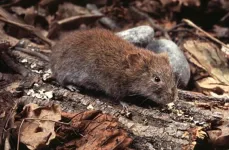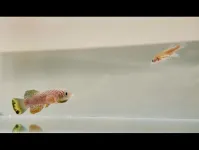(Press-News.org) Researchers have discovered that bank voles in southern Sweden (Skåne) carry a virus that can cause hemorrhagic fever in humans. This finding was made more than 500 km south of the previously known range. The virus strain discovered in Skåne appears to be more closely related to strains from Finland and Karelia than to the variants found in northern Sweden and Denmark. This is revealed in a new study from Uppsala University, conducted in collaboration with infectious diseases doctors in Kristianstad and published in the scientific journal Emerging Infectious Diseases.
“We were surprised that such high proportion of the relatively few voles that we caught were actually carrying a hantavirus that makes people ill. And this was in an area more than 500 km south of the previously known range of the virus,” says Elin Economou Lundeberg, infectious diseases doctor at Kristianstad Central Hospital, who is one of the study’s first authors.
Hantaviruses are a family of viruses naturally found mainly in rodents such as mice, rats and voles. Certain hantaviruses are able to infect people and cause two main groups of diseases: hemorrhagic fever with renal syndrome (HFRS) and hantavirus pulmonary syndrome (HPS). Both types of disease are notifiable under the Communicable Diseases Act, as they can cause serious problems and even death. In northern and central Europe, a variant of the virus, Puumala hantavirus, causes a relatively mild form of HRFS popularly known as ‘vole fever’ (nephropathia epidemica). However, studies have shown that this hantavirus can also cause very severe HRFS, which in the worst case can be fatal. In Sweden 100–450 cases of vole fever require hospital care each year, exclusively in the northern part of the country.
In 2018, a locally contracted case of vole fever was reported in Skåne, more than 500 km south of the previously known southernmost incidence of the disease in Sweden, which was north of Uppsala. Another case was discovered in 2020, also in Skåne. In both cases, the patients concerned had not been away travelling and were infected in their home area. In an attempt to understand how this was possible, bank voles were caught in the vicinity of the patients’ homes and analysed for any occurrence of hantavirus. It turned out that 9 of the 74 bank voles caught carried hantavirus genes. Genetic studies have now showned that the virus differs markedly from the virus variants that circulate in northern Sweden and Denmark, and that it is most closely related to viruses from Finland and Karelia.
The next step in the research is to find out where the virus comes from and map its distribution in the southern parts of Sweden.
“If the virus has existed in the area for a long time and has simply not been discovered, why haven’t more people become ill? Or, has it become established in Skåne recently and only just begun to spread? And how did it get there?” wonders Professor Åke Lundkvist of Uppsala University, a co-author of the study. “Unfortunately the COVID-19 pandemic intervened, which considerably delayed the completion of this study. These findings are very interesting and show how important it is to investigate the causes as quickly as possible when we see an infectious disease in a new geographical area.”
The study was financed by the EU (Horizon 2020) and SciLifeLab (Pandemic Laboratory Preparedness), along with local R&D funding from Kristianstad Central Hospital.
Ling J, Lundeberg EE, Wasberg A, Faria IR, Vucicevic S, Settergren B, et al. Nephropathia epidemica caused by Puumala virus in bank voles, Scania, Southern Sweden. Emerg Infect Dis. 2024 Apr, https://wwwnc.cdc.gov/eid/article/30/4/23-1414_article
END
Finnish Vole fever spreading further south
2024-05-28
ELSE PRESS RELEASES FROM THIS DATE:
Prenatal exposure to air pollution associated with increased mental health risks
2024-05-28
A baby’s exposure to air pollution while in the womb is associated with the development of certain mental health problems once the infant reaches adolescence, new research has found. The University of Bristol-led study, published in JAMA Network Open today [28 May], examined the long-term mental health impact of early-life exposure to air and noise pollution.
Growing evidence suggests air pollution, which comprises toxic gases and particulate matter, might contribute to the onset of mental health problems. It is thought that pollution could negatively affect mental health via numerous ...
New research supports expansion of kidney donation to include organs from deceased patients who once had dialysis
2024-05-28
Researchers from Johns Hopkins Medicine propose a novel approach to addressing the pressing issue of a kidney donor shortage through findings that suggest a promising method to expand the pool of available kidney donors by utilizing deceased donors on dialysis for kidney transplants.
The findings, published in the May 23rd issue of JAMA, identifies that while those who received such kidneys experienced a “significant delay” in the function of the transplanted organ compared to those ...
A cleaner way to produce ammonia
2024-05-28
– By Rachel Berkowitz
Ammonia is the starting point for the fertilizers that have secured the world’s food supply for the last century. It’s also a main component of cleaning products, and is even considered as a future carbon-free replacement for fossil fuels in vehicles. But synthesizing ammonia from molecular nitrogen is an energy-intensive industrial process, due to the high temperatures and pressures at which the standard reaction proceeds. Scientists from the Department of Energy's Lawrence Berkeley ...
How killifish embryos use suspended animation to survive over 8 months of drought
2024-05-28
The African turquoise killifish lives in ephemeral ponds in Zimbabwe and Mozambique. To survive the annual dry season, the fish’s embryos enter a state of extreme suspended animation or “diapause” for approximately 8 months. Now, researchers have uncovered the mechanisms that enabled the killifish to evolve this extreme survival state. They report May 30 in the journal Cell that although killifish evolved diapause less than 18 million years ago, they did so by co-opting ancient genes ...
Harnessing green energy from plants depends on their circadian rhythms
2024-05-28
WASHINGTON, May 28, 2024 —When plants draw water from their roots to nourish their stems and leaves, they produce an electric potential that could be harnessed as a renewable energy source. However, like all living things, plants are subject to a circadian rhythm — the biological clock that runs through day and night cycles and influences biological processes. In plants, this daily cycle includes capturing light energy for photosynthesis and absorbing water and nutrients from the soil during the day and slowing its growth processes at night.
In a study published this week in ...
Financial burden of health care in the privately insured US population
2024-05-28
About The Study: In this national cross-sectional study of privately insured U.S. families, inflation-adjusted health care spending increased from 2007 to 2019, largely owing to increasing contributions to premiums. Annual financial medical burden increased significantly, both overall and among low-income and higher-income families. Mean financial medical burden was more than 26% of postsubsistence income for low-income families, compared with approximately 6% for higher-income families.
Corresponding ...
Mortality risk among women with premenstrual disorders in Sweden
2024-05-28
About The Study: The findings of this matched cohort study suggest that women with premenstrual disorders are not at increased risk of early death overall. However, the risk was elevated among young women and for death by suicide. This supports the importance of careful follow-up for young patients and highlights the need to develop suicide prevention strategies for all women with premenstrual disorders.
Corresponding Author: To contact the corresponding author, Marion Opatowski, Ph.D., email marion.opatowski@ki.se.
To access the embargoed ...
Early vs late anticoagulation in minor, moderate, and major ischemic stroke with atrial fibrillation
2024-05-28
About The Study: The treatment effect of early direct oral anticoagulant initiation did not differ in people with minor, moderate, or major stroke assessed by brain imaging. Early treatment was not associated with a higher rate of adverse events, especially symptomatic intracranial hemorrhage, for any infarct size, including major stroke.
Corresponding Author: To contact the corresponding author, Urs Fischer, M.D., M.Sc., email urs.fischer@insel.ch.
To access the embargoed study: Visit our For The Media website at this link https://media.jamanetwork.com/
(doi:10.1001/jamaneurol.2024.1450)
Editor’s ...
Air and noise pollution exposure in early life and mental health from adolescence to young adulthood
2024-05-28
About The Study: Early-life air and noise pollution exposure were prospectively associated with three common mental health problems (psychotic experiences, depression, and anxiety) from adolescence to young adulthood in this longitudinal cohort study. There was a degree of specificity in terms of pollutant-timing-outcome associations. Interventions to reduce air and noise pollution exposure (e.g., clean air zones) could potentially improve population mental health. Replication using quasi-experimental designs is now needed to shed further light on the underlying ...
New research shows soil microorganisms could produce additional greenhouse gas emissions from thawing permafrost
2024-05-28
As the planet has warmed, scientists have long been concerned about the potential for harmful greenhouse gasses to seep out of thawing Arctic permafrost. Recent estimates suggest that by 2100 the amount of carbon dioxide and methane released from these perpetually frozen lands could be on par with emissions from large industrial countries. However, new research led by a team of Colorado State University microbiome scientists suggests those estimates might be too low.
Microorganisms are responsible for the process that will generate greenhouse gasses from thawing northern peatlands, which contain about ...





